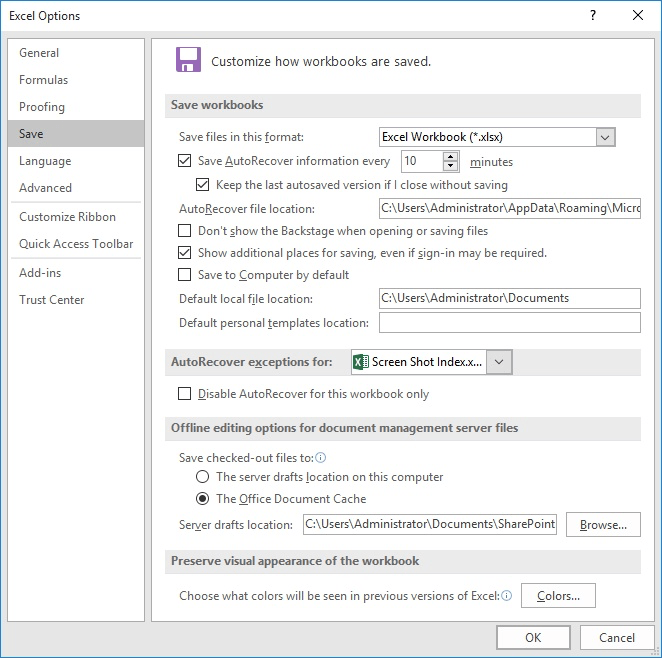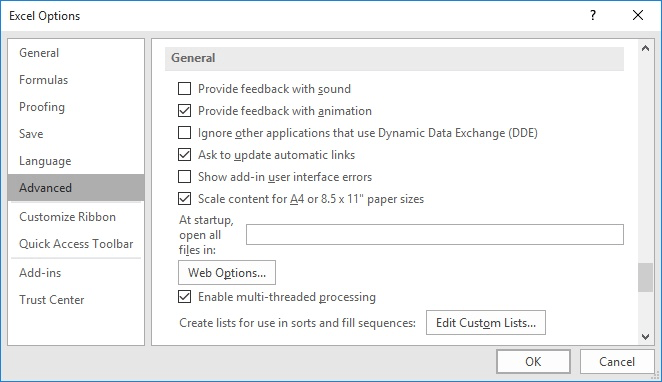Please Note: This article is written for users of the following Microsoft Excel versions: 2007, 2010, 2013, 2016, 2019, 2021, and Excel in Microsoft 365. If you are using an earlier version (Excel 2003 or earlier), this tip may not work for you. For a version of this tip written specifically for earlier versions of Excel, click here: Loading Unwanted Files at Startup.
Written by Allen Wyatt (last updated April 22, 2023)
This tip applies to Excel 2007, 2010, 2013, 2016, 2019, 2021, and Excel in Microsoft 365
Stephen ran into a problem using Excel—every time he starts the program, Excel tries to load all the files in the root directory as spreadsheets. This, of course, messes up his use of Excel.
This problem typically occurs when someone has instructed Excel to load those files. To undo this, follow these steps:

Figure 1. The Save options of the Excel Options dialog box.

Figure 2. The advanced options of the Excel Options dialog box.
The options in steps 3 and 5 represent directories whose files Excel should load whenever you start the program. If you don't want Excel to load any files when it starts, just clear the settings in these options, or make sure they are set to directories that really contain things you want loaded.
It is possible that if one of these options is set to C: (the root directory on a Windows system), and you have a lot of files in the root directory, then Excel will try to load so many files that you won't be able to use it at all in order to perform these steps. If that happens to you, use Windows to move the files from the root directory to a temporary directory, and then start Excel. (You won't have to move any of the folders in the root directory, just files.) Once you change the settings in Excel, as described above, you can use Windows to move the files from the temporary directory back to the root directory.
ExcelTips is your source for cost-effective Microsoft Excel training. This tip (6226) applies to Microsoft Excel 2007, 2010, 2013, 2016, 2019, 2021, and Excel in Microsoft 365. You can find a version of this tip for the older menu interface of Excel here: Loading Unwanted Files at Startup.

Professional Development Guidance! Four world-class developers offer start-to-finish guidance for building powerful, robust, and secure applications with Excel. The authors show how to consistently make the right design decisions and make the most of Excel's powerful features. Check out Professional Excel Development today!
Workbooks are loaded from disk files, but workbooks aren't the only type of files that Excel can load. This tip provides ...
Discover MoreIf you import data into Excel that is created by other programs, you know that it can be bothersome to get your data ...
Discover MoreOpen a workbook that someone else is working on, and you won't be able to save your changes back into the same file. ...
Discover MoreFREE SERVICE: Get tips like this every week in ExcelTips, a free productivity newsletter. Enter your address and click "Subscribe."
There are currently no comments for this tip. (Be the first to leave your comment—just use the simple form above!)
Got a version of Excel that uses the ribbon interface (Excel 2007 or later)? This site is for you! If you use an earlier version of Excel, visit our ExcelTips site focusing on the menu interface.
FREE SERVICE: Get tips like this every week in ExcelTips, a free productivity newsletter. Enter your address and click "Subscribe."
Copyright © 2025 Sharon Parq Associates, Inc.
Comments